
How to Write a Synthesis Essay to Impress And Get A+
Students’ first thought when a teacher assigns a synthesis essay is something like, “What? Synthesis? Isn’t it anything from chemistry classes?”
Indeed, this essay type isn’t as popular as narrative, critical, or personal papers you regularly write in college. That’s why it would help to know how to write a synthesis essay beforehand, to meet a situation hand-on once it appears, agree?
And we’re here to get you through the process of synthesis paper writing!
First, in short:
Here’s how to write a synthesis essay, step by step:
- Choose a topic.
- Decide on sources.
- Do research and analyze the position of each source.
- Craft a thesis statement.
- Write a synthesis essay outline.
- Write a draft with a strong intro and conclusion.
- Proofread your essay and ensure you cite the sources right.
And those willing to get more details and synthesis essay examples, keep reading! 🙂
Table of Contents:
What Does Synthesis Mean?

Go to online dictionaries for the definition, and you’ll see they explain synthesis to be whether “the combination of elements to form a connected whole” or “the production of chemical compounds by reaction from simpler materials.”
It stands to reason that a synthesis essay writing has nothing to do with chemistry. It has simply got its name from the nature of that chemical reaction.
In the academic world, synthesis is about written discussions incorporating arguments from several sources. You examine resources of different views on the topic and identify their relationship to your thesis statement.
Where do we use synthesis in writing?
- Business papers, when examining different ideas and combining them into a coherent plan.
- Analysis papers, when exploring related theories.
- Research papers, when incorporating multiple resources to prove/disprove a hypothesis or support work with data.
- Argument papers, when comparing different views to support a claim.
“Thank you, but I’m here to learn how to write a synthesis essay and get an A for this assignment,” you say.
Take your time, and let’s explore everything step by step, deal?
What Is a Synthesis Essay?
A synthesis essay is a type of paper gathering the information from several resources to form a new thesis and then explain or argue it.
A synthesis essay is also an integral part of the AP Language exam, the first out of three papers you’ll need to write to pass.
(If you are here to read about how to write a synthesis essay for the AP Lang exam specifically, feel free to jump right to the corresponding section of this article. All the details and tips are waiting for you there.)
And now, we continue on a synthesis paper in general.
In a synthesis essay, you need to analyze several different sources and use the relevant information from them to support your statement. But it’s not about utilizing or summarizing other authors’ ideas.
The point is NOT to repeat opinions from your sources but use them to formulate and support your position:
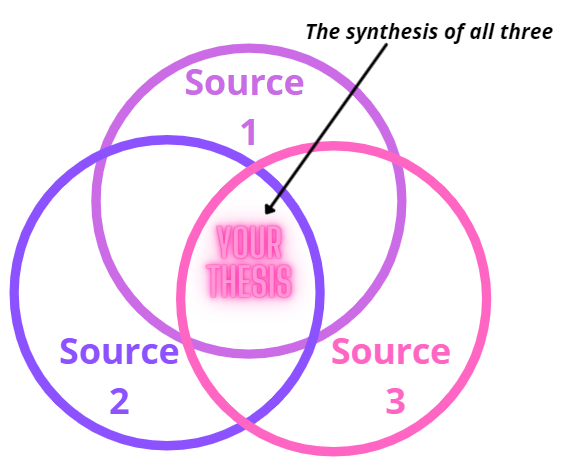
For your synthesis essay to succeed, you should also include the opposite side’s information.
What does it mean?
When choosing the resources to analyze in your synthesis essay, don’t take only those supporting your position. Please do your best to include the counterarguments and your thoughts on them: It will show teachers that you understand a problem and increase your chances of getting a high grade.
Two Types of Synthesis Essay
There are two main types of synthesis essays: explanatory and argumentative. While their structure is the same, their nature is a bit different:
- Explanatory synthesis essays: You take a few sources, explain their ideas, and reveal connections and differences between them. Here you don’t need to choose a side or persuade readers to take one. Just examine the similarities and differences between ideas. It reminds writing a typical expository essay.
- Argumentative synthesis essays: You take a few sources, present your own opinion (thesis), and support it with the appropriate information from those sources. It looks like a typical argumentative essay, with a thesis arguing one specific yet debatable point.
While explanatory synthesis essays are more typical for general writing assignments in schools or universities, an argumentative synthesis essay is a case for the AP Language exam.
Synthesis Essay Structure
Synthesis essays often follow a standard five-paragraph essay structure: an introduction, three body paragraphs, and a conclusion.
And yet, there are a few slight nuances to keep in mind when writing this particular type of essay.
1) Introduction
This paragraph introduces your sources, addresses the general landscape of ideas you’re going to discuss, and states the thesis of your synthesis essay.
As a rule, the thesis statement takes 1-2 sentences at the very end of your introductory paragraph.
Read: How to Start a College Essay Like a Boss
2) Body
The number of body paragraphs in your essay depends on how many sources you’re going to “synthesize.” Usually, it’s three: two sections synthesize sources that support an argument of your thesis, and the third one introduces the source with the opposing views.
When writing a synthesis essay based on two sources, you are free to include just two paragraphs in the essay body. The general guideline for writing an AP Lang synthesis essay is 3-4 well-constructed body paragraphs.
3) Conclusion
This paragraph restates your thesis, reviewing the ideas you addressed in the essay body and emphasizing how each point proved it.
A good essay conclusion gives readers food for thought, summing up your writing and answering a “So what?” question. As a rule, it consists of three sentences minimum.
Read: How to Write a Strong Conclusion for Your Essay
4) Bibliography
As well as most other essay types, synthesis papers include a list of sources at the end. Depending on style guidelines in your assignment — APA, MLA, Chicago, etc. — you’ll need to structure it properly.
This list of citations typically takes 1-2 pages at the end of your essay, after the conclusion.
And now, to more practical things:
Here goes a synthesis essay template for you to customize every time you wonder how to structure your paper right:
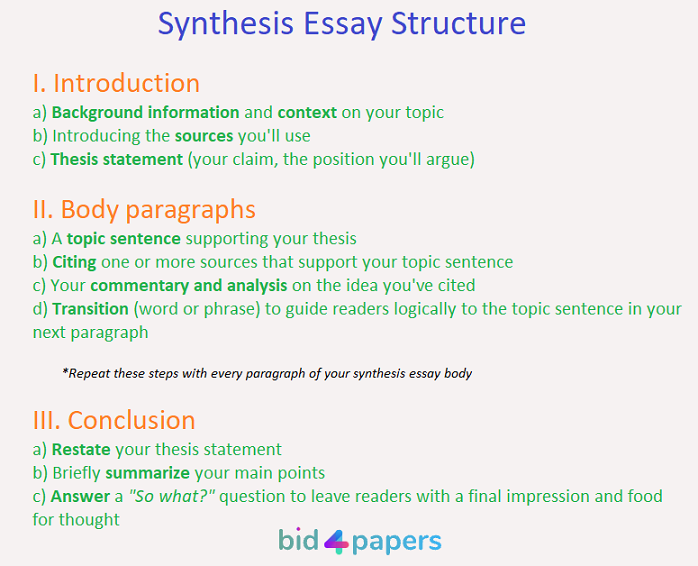
How to Write a Good Synthesis Essay
Below you’ll find the seven steps on how to write a synthesis essay so it would look and sound professional enough for an A+. These guidelines are for typical synthesis papers your teachers assign in school or college. If looking for tips on writing a synthesis essay for AP Language and Composition exam, please jump to the next section of this post.
So, here we go:
1) Choose a Topic
As a rule, teachers provide students with essay prompts or topics. The topics of synthesis essays are often about social behavior and the nature of people interaction, which is debatable enough to formulate an opinion.
If you get a synthesis essay topic assigned, read it carefully:
Your task here is to understand the context and the purpose of this essay. What do you need to do here? Examine, evaluate, argue, compare, or maybe provide a recommendation? Your grade for a synthesis paper will depend heavily on it.
If you don’t get any specific topic assigned, feel free to choose the one of your interest. Brainstorm a few college essay ideas and decide on the most interesting for you to cover.
Here go a few synthesis topic ideas for your inspiration:
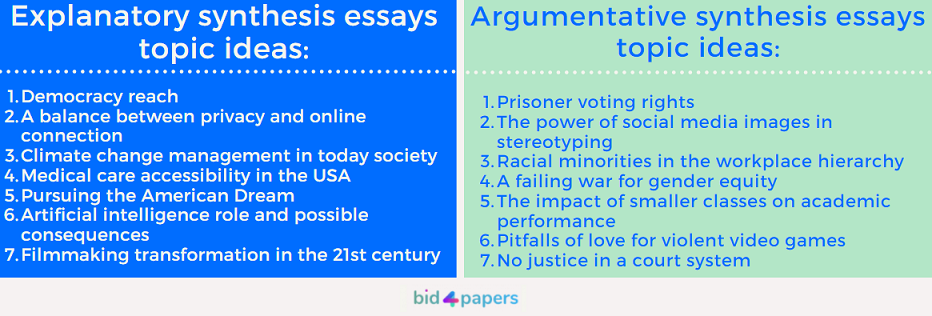
Read: Secrets of Choosing Good Argumentative Essay Topics
2) Decide on Sources
If a teacher assigns a synthesis essay topic, they’ll either provide you with sources to use or specify the number of materials to synthesize in an essay.
Usually, it’s at least three sources to reference in your essay.
But if they aren’t specified beforehand, you’ll need to do research and examine 6-8 different books, articles, or journals to decide on three resources to use for an essay. It can be scientific studies, quotes from scholars, or any other academic materials relevant to your topic.
Ensure you choose credible sources, unbiased and objective enough to help you develop a point of view on the topic. It’s also critical to identify central concepts of each resource you’re going to use:
Ensure there’s a central concept across all the materials because it will help you examine their relationships and write about them.
3) Do Research
Once you’ve decided on a few sources to use for your synthesis essay, it’s time to read them carefully to formulate your thesis and find information to support it.
Research your chosen materials:
- Analyze the position of each source
- Note similarities and differences between their central concepts
- Write down arguments that support and oppose your position
- Decide on passages you’ll quote
By the time you finish, you should have a more or less clear picture of your synthesis essay outline.
Hint: Analyzing the position of each source, use these verbs to note what the author does:

4) Come Up With a Thesis Statement
A thesis statement of your synthesis essay should summarize your position on the topic and outline the arguments you will make to support it.
It’s a one- or two-sentence summary of an essay that will reflect your claim and the core idea behind the paper. When writing it, keep in mind the purpose of your synthesis essay.
You can include the factors or reasons that influenced your position on the topic and counterarguments that can undermine your claim.
Sounds too challenging?
Our thesis statement generator will help you introduce the idea of your paper and come up with a strong thesis statement for your synthesis essay.
5) Write a Synthesis Essay Outline
Please don’t ignore this step when writing your essay: While it may seem a waste of time, an outline is your sure-fire way to write a paper quickly and efficiently.
In plain English, it’s a plan of your synthesis essay. The standard outline consists of three parts: an introduction, a body, and a conclusion; you can apply it for synthesis essays too, but with a primary focus on outlining your body paragraphs.
Depending on how you decide to organize an essay, the structure of its body paragraphs may differ.
Here are three strategies to consider for organizing your synthesis essay:
- Climatic order: That’s when you place the most powerful argument to the last paragraph so it would be more memorable and impactful.
- Problem and solution: That’s when you establish a problem in your essay introduction and then offer a few solutions to it in the essay body paragraphs.
- Comparison and contrast: That’s when you summarize each source, showing their similarities and differences; or when you move back and forth between the items compared; or when you set items into blocks, entirely discussing the one before moving on to the next.
But no matter what structure you choose for your essay, ensure you DON’T structure its body by source. Avoid the “one source = one paragraph” scheme; instead, plan your essay by factors and arguments:
One point/argument = one paragraph = data from different sources you synthesize to support the point.
Another important detail:
Ensure you devote one paragraph of your synthesis essay to counterarguments. It will show teachers that you understand the depth and complexity of the topic and consider it from different angles. Add this paragraph to your essay outline, too.
Read: How to Write a Perfect Essay Outline
6) Write a Draft
Now it’s time to write a synthesis essay according to your outline.
Start with an introduction: Present a topic, provide background information, introduce sources, and write a hook for your essay to capture readers’ attention. Remember a thesis statement: Place it at the end of your introductory paragraph.
Write body paragraphs: Typically, they are three, and each one consists of three sections — a topic sentence, supporting sentences, and a closing (transition) sentence. Please do your best to provide clear and concise information, discussing arguments of your thesis with evidence from each source. Remember counterarguments: Mention how they can negate your claim and what you have to support your idea anyway.
Here go some standard rules on how to write a synthesis essay:
- Write in the third person. (Consider”he,” “she,” “they,” “it.”)
- Use active voice.
- Use transitions between paragraphs for your text to flow logically.
- Write in present tense if using MLA style; use past tense when writing in APA citation style.
- Don’t start paragraphs with quotations.
How to write a conclusion for a synthesis essay
In the last paragraph of your paper, summarize your entire work and offer readers your final impression on its central idea. Here you’ll need to restate the thesis and synthesize the essay’s main points, emphasizing the significance of its topic.
Here go the parts of your synthesis essay conclusion:
- Summary – a brief overview of your essay: the main points you presented in the body.
- Synthesis – showing how the main points of your paper are interconnected; explain how they fit together to support your thesis.
- Restated thesis – remind readers what the main point of your essay was.
- Significance – explain why the topic matters; try to give readers food for thought, leaving them with the big picture of how your topic fits into the larger scheme of things.

Source: Community College of Denver
7) Proofread and Edit Your Synthesis Essay
Don’t hurry up to submit your essay to a teacher once your draft is ready! A good practice is to proofread it and ensure it has no spelling, syntax, or grammatical errors.
Hint: Read it out loud. Therefore, you’ll prevent scanning and make it easier to see every typo or weird grammar construction. Feel free to copy and paste the text of your essay to our handy tool: Read My Essay will do the job for you.
Read your work two or three times to ensure all the points flow logically.
Hint: Proofread and edit your essay the next day after writing. Therefore, you’ll look at it with a fresh pair of eyes to notice slight details you might miss.
Check your bibliography carefully to make sure you’ve cited the source materials right. Also, please pay attention to your footnotes and in-text citations: Consider the citation style your teacher prescribed and follow its formatting rules.
(For college essays, MLA and APA or Chicago styles are most popular; for a synthesis essay AP Lang test, no specific style is required, but you’ll need to state your source after you cite it anyway.)
How to Write a Synthesis Essay AP Lang
Most students looking for information on how to write a synthesis essay want to get practical tips on writing this essay as a part of the AP Language and Composition exam.
What is that? What differentiates it from traditional essay writing? And how to write a synthesis essay AP Lang to get a high grade?
Let’s put the things right.
What is AP Lang?
AP Lang refers to the AP Language and Composition exam students take in high schools to earn scores for college credit. It tests your rhetorical and composition skills: the ability to understand how authors use language to communicate their message and apply these techniques to your own writing.
The exam consists of two sections:
- A multiple-choice section: You’ll have 60 minutes to answer 45 multiple-choice questions. It’s worth 45% of your score.
- A free-response section: You’ll have 2 hours and 15 minutes to write three essays: synthesis, rhetorical analysis, and argumentative ones. It’s worth the other 55% of your score.
| Section | Timing | Questions | Scores |
| Section 1 | 60 minutes |
45 multiple-choice questions:
|
45% |
| Section 2 | 2 hours and 15 minutes | 3 free-response questions:
|
55% |
In 2022, the AP Lang exam takes place on May 10.
Writing a Synthesis Essay for AP Lang Exams
Here’s the structure of the AP Lang synthesis essay task:
They’ll give you six to seven sources organized around a specific topic and a three-paragraph prompt that briefly explains a claim you’ll need to respond to in your essay, synthesizing the material from at least three sources provided.
At least two sources are visual; one is quantitative (a graph or a chart, for example), and the others are text-based (approximately 500 words each).
That’s what an AP Lang synthesis essay task looked like in 2015:
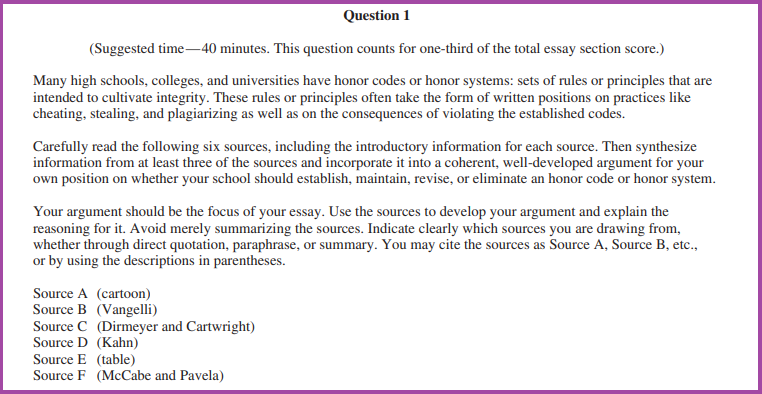 Source: College Board
Source: College Board
Read: Why Students Plagiarize
And that’s what you need to do to write a synthesis essay AP Lang like a boss:
1) Ensure you understand the prompt:
Before you start writing, determine what the prompt asks you to do in an essay: evaluate a topic, judge it, defend, argue, respond to it, etc. Read each paragraph carefully and identify the most critical details.
Don’t hurry up; spend around two minutes reading, and focus on the imperative verbs in the prompt. Make notes if necessary.
2) Read the source materials carefully:
Now it’s time to read ALL the sources quickly but carefully. Use a pencil to underline core information and add notes as you go. While reading, think about how this information influences a claim you have in the prompt.
They recommend you take about 15 minutes to read the sources. Ensure you summarize each source’s position: whether it defends or challenges the claim in the prompt. It will help you choose three sources to synthesize and refer to in your essay.
3) Craft a thesis statement:
After reading the sources, it’s time to develop your opinion on the topic provided. It will help you brainstorm and formulate a thesis statement for your synthesis essay.
Hint: Essay prompts usually give a few choices for how you can frame a thesis statement. Thus, in the above example, you can choose whether defend or challenge the topic: “…whether your school should establish, maintain, revise, or eliminate an honor code or honor system.”
Based on your stance, generate a solid argumentative thesis statement for your synthesis essay. It should state your position and establish reasoning on the issue. Remember about the sources you’ll later use to support your claim.
4) Sketch an outline:
Once your tentative thesis statement is ready, outline your essay: write down a thesis statement, supporting points you’ll use as topic sentences in body paragraphs, and ideas of how to incorporate your sources.
Spend 5 to 10 minutes outlining your essay, and don’t worry that you won’t have enough time for writing. Specifying each piece of content that you’ll include in the draft, you’ll get a map of your final essay and make the writing process faster and easier.
5) Write an essay:
Now it’s time to write a synthesis essay. You can choose a few ways to organize it — remember three strategies we outlined earlier: climatic order, problem/solution, and comparison/contrast? — but a standard essay structure would work best here. It will save you time and help you organize everything clear.
*Consider a synthesis essay template we’ve shared earlier in this article.
Do your best to focus on your commentary while writing. To earn points for an AP Lang synthesis essay, you’ll need to explain your argument and sources, not simply retell the authors’ position. Teachers will expect you to incorporate quotations, paraphrases, and summaries from sources and interpret them to readers.
Synthesis Essay Example
Synthesis essay prompts and examples are many throughout the internet. You can find official ones at the AP Central College Board portal to check what students wrote in previous years and get a better idea of what to expect (and what’s expected from you.)
Here we’ll share one synthesis essay example for TL;DR fans and provide a few alternative resources to check.
So, that was the prompt last year (2021):

And that’s what a student wrote:
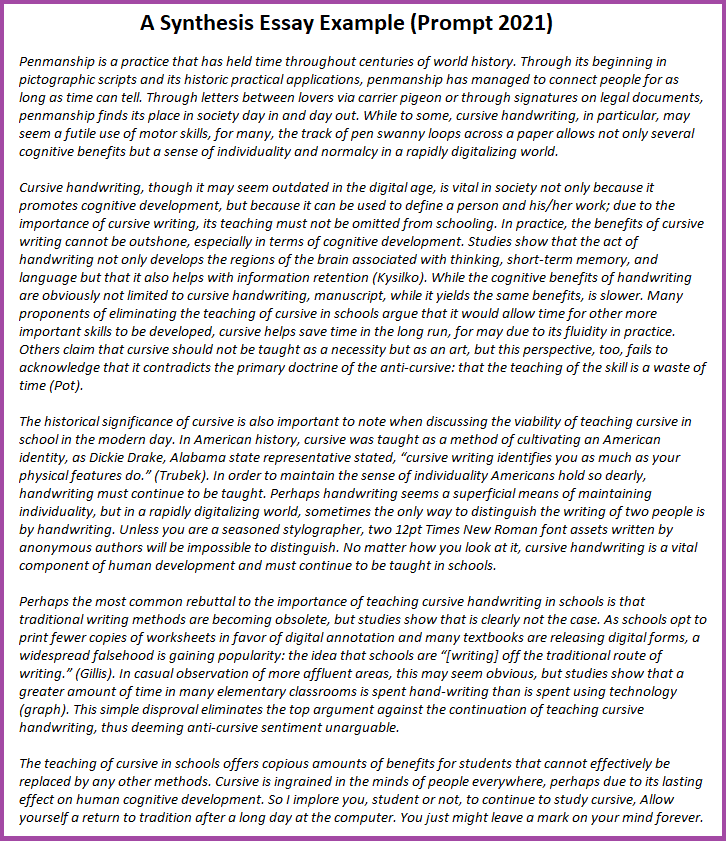
More synthesis essay examples: 1, 2, 3.
And now that you know how to write a synthesis essay to earn extra points for your college credit, why not give it a try and practice a bit? If you have any questions left, our writers are always here to help!